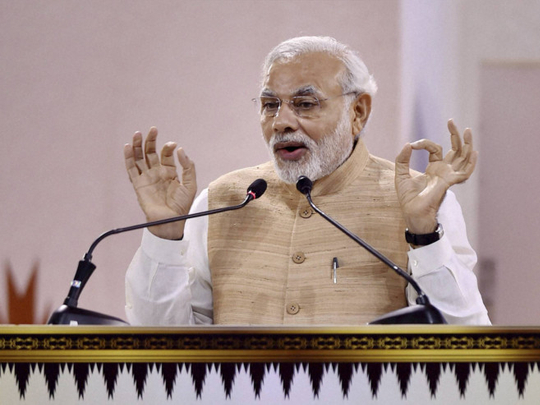
When he gave his first Independence Day speech last August, Indian Prime Minister Narendra Modi larded the address with major policy ideas. He announced his flagship “Make in India” plan to develop a globally-competitive manufacturing sector. He urged a “Clean India” drive to improve sanitation. He abolished the Planning Commission, a relic of India’s failed tryst with socialism. Today, when he again ascends the ramparts of Delhi’s Red Fort, he’s got to think even bigger.
That doesn’t mean more schemes or slogans or flagship programmes — there have been enough of those already in the past year. The problem is that most are stalled or have yet to get off the ground, and even some of Modi’s strongest backers are beginning to wonder if his administration is committed to or capable of truly transformative change.
This can’t all be blamed on the dysfunctional legislature, whose opposition-dominated upper house has successfully prevented any business during the current “monsoon” session of Parliament. Modi’s government now seems all-too-ready to water down two key pieces of legislation: a law on acquiring land and a nationwide goods-and-services tax. It’s agreed to restore the clauses requiring consent and time-consuming social-impact assessments to the former bill and to accept high rates and multiple exemptions in the latter — exactly what the Goods and Services Tax (GST) was meant to replace.
Why hasn’t Modi lived up to the reformist promise he seemed to exude in his 2014 election campaign? Some of the reasons are obvious. The central government bureaucracy favours the status quo and opposes radical reform; its conservativism may have influenced the prime minister. Also, Modi may have erred in trying to replicate his experience as Gujarat chief minister by centralising too many decisions. India is several times larger and more complex than Gujarat and a highly concentrated decision-making process slows things down dramatically.
No doubt, too, Modi’s been stung by accusations that his is a pro-business, anti-poor government, one that aims to steal land from poverty-stricken farmers and throw labourers out of work in order to benefit capitalist cronies. Sectarian controversies stirred up by his right-wing Hindu nationalist supporters have given the opposition plenty more ammunition to lob at the government.
Whatever the reasons, Modi has to find a way to regain control over the narrative if he’s to have any hope of achieving substantive reforms during his term. Today, he needs to send a clear signal that he’s determined to push ahead with the vision he sold during the elections — “minimum government, maximum governance.”
One obvious way to do so would be to take on India’s large and politically-influential public sector. Curiously, Modi’s government seems intent on reviving chronically sick government-owned companies, such as the two telecom companies MTNL and BSNL and the national air carrier Air India. There’s simply no justification to spend taxpayers’ money on these loss-making concerns. The telecom sector is vibrant and competitive and doesn’t need state-owned companies. The airline industry features plenty of private players whose competitiveness is dragged down by a subsidised Air India. At least for money- losing state firms, Modi’s priorities should be clear: sell or shut down.
The prime minister also needs to signal to his obdurate bureaucracy that he means business. He could begin by challenging the country’s notorious taxmen, who continue only to enhance India’s reputation for the arbitrary and unpredictable enforcement of rules, particularly on foreign companies. Modi should intervene early to prevent officials from implementing ambiguous laws in a ham-fisted manner. It might help, too, if tax officials weren’t presented with impossible revenue targets.
Most importantly, Modi needs to convince Indians once again that enacting pro-investment policies is in fact the only pro- poor strategy in the medium term. Reforms to land and labour laws aren’t simply measures to lure business. Only if investment pours in can jobs be created. India’s existing labour laws protect only the 7 per cent of the workforce in the organised sector. Its land laws protect only the minority of farmers who own their land, not the millions of landless labourers who toil for meagre wages and would be better off with a factory job. The government must make the benefits of reform clearer and do more to mitigate its costs. None of this is new for Modi. He delivered a similar message during the elections, without perhaps being entirely forthcoming with voters about how difficult these changes would be and how long it might take to see results. His task may be tougher now, but it’s even more vital.
— Washington Post
Dhiraj Nayyar is a journalist in New Delhi.









